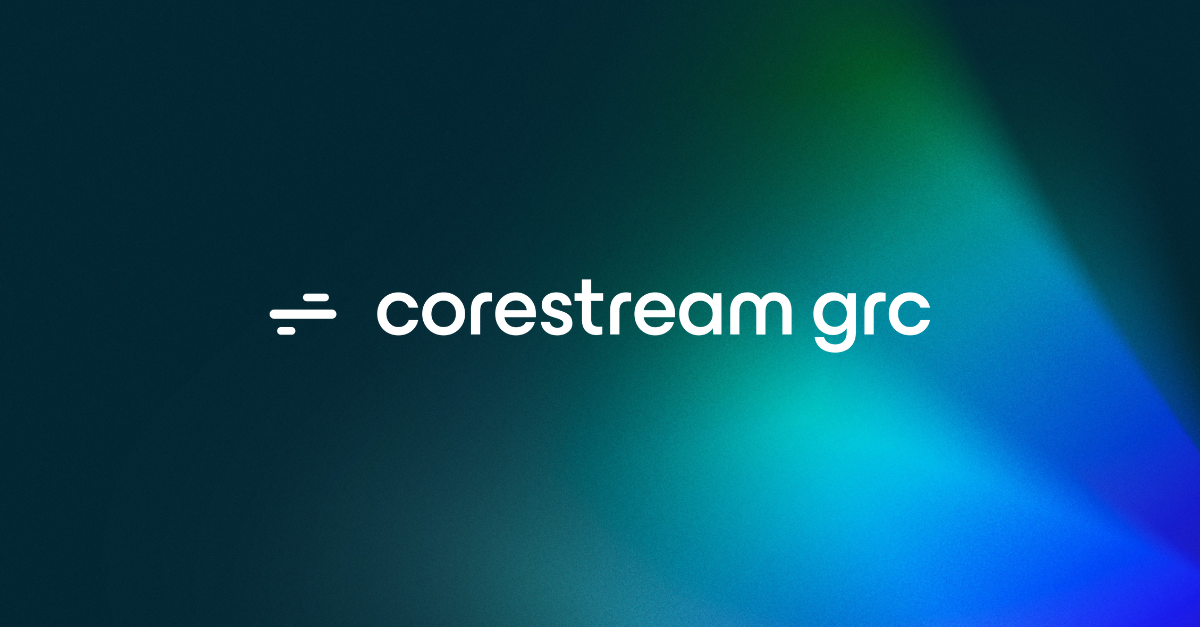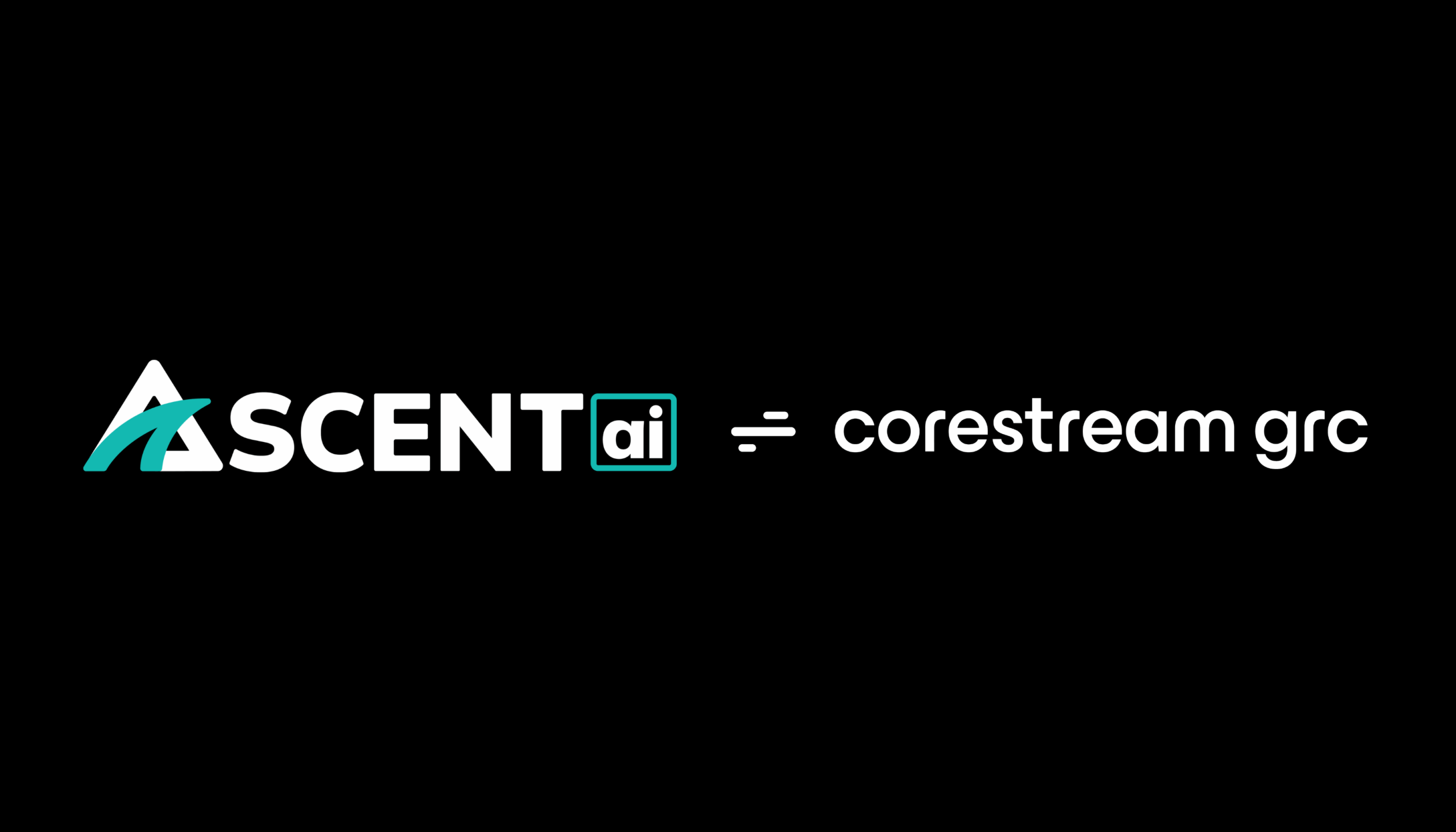1.0 Document Purpose
This document provides highlights of the CoreStream Release 3.1 release. Major Platform releases are finalized every 2-3 months depending on client and strategic priorities. These release notes are part of CoreStream GRC’s approach to keeping clients and partners informed of the improvements we are delivering.
This document includes key user stories and issue fixes;
some are available automatically as part of the platform upgrade, while others require a configuration change; this is specified against each change.
Changes fall into one of the following categories:
| Strategic Features | The introduction of new Platform features considered to be of strategic importance. |
| Core Features | Improvements to existing features or new functionality that is more limited in scope than the strategic features. |
| Configuration Improvements | Changes relating to improvements to our approach to configuration, focused on improving the efficiency, accuracy and consistency of Platform configuration. |
| Issue Fixing | The resolution of Platform issues. |
| Integrations | External applications or systems that CoreStream GRC has integrated with. |
| Technical | Improvements to the technical Platform elements. These improvements are typically non-functional. |
Please note that each category will not feature in every release update and some may be more heavily weighted towards certain categories. As always, the plan is to focus on those items that add the most value to our clients.
2.0 Platform Team Overview
CoreStream GRC 3.1 is now live, delivering some of our most impactful enhancements yet. Leading the way is our new Reorganization Tool, which takes the complexity out of updating hierarchies and the content associated with them. A number of our clients are large and undertake frequent reorganizations. This feature removes any manual effort in restructuring hierarchies in CoreStream GRC and ensuring that content owned by each area can be automatically reallocated. Built in the typical CoreStream GRC way, this feature is generic, meaning that it can be applied to other types of hierarchy such as risk taxonomies or process frameworks.
We’ve also introduced calculated fields directly in forms, giving you real-time results and enabling smarter, more dynamic workflows without waiting for a save. Field can be calculated in real-time once the necessary inputs have been provided, ensuring users receive instant feedback. The most frequently requested use of this feature is calculating a risk score when impact and likelihood values are provided, but it applies to many others too. Previously, such calculations required a user to save and continue or exit the form entirely to see the output. Not any more!
Personalization is a key focus for CoreStream GRC and we have made progress in 3.1. Filters applied to grids and dashboards can now be remembered for your next visit, bookmarks let you jump straight to your most-used pages, and shared filters across dashboards save you even more time. These updates help you work in a way that suits you best and serves to reduce the clicks required to achieve the desired result.
Rounding out the release are improvements to accessibility and keyboard navigation, new export capabilities such as flattened Excel outputs from tree reviews and a wizard-based API export generator, plus a host of smaller enhancements that make everyday work in CoreStream faster, smoother, and more intuitive.
Please keep the ideas coming. It is input from our community that means we can prioritize the right things.
Rich & Cam
3.0 Release Notes
3.1 Strategic Features
Calculated Fields in Forms
Configuration Required
CoreStream GRC has long supported a wide range of calculation logic – from simple formulas like impact × likelihood for risk scores to highly complex queries (for example, summing weighted scores and comparing them against a business unit’s set risk appetite thresholds in a separate table). Historically, these calculations ran only when the form was saved. While effective, this meant you couldn’t see results in real time and limited our ability to guide you dynamically (for example, showing certain buttons or steering workflow paths based on calculated values). Now, we’ve brought the logic directly into the form. You’ll see results instantly as you complete it, enabling a smoother, more intuitive user experience. It’s a win-win!

Re-Organization Tool
Configuration Required
Organizational restructures and hierarchy changes – whether involving departments, portfolios/program/projects, or risk registers – can be complex and error-prone. Moving one department often means shifting all its sub-levels and re-linking associated content such as risks, controls, processes, and actions. We’ve automated this process to save time and reduce errors. Now, you can select any node in the hierarchy, move it anywhere else (even to a different level), and CoreStream GRC will handle all the underlying logic in the background – ensuring that the hierarchy node and levels linked to it are repositioned, and all related content is updated in line with the updated hierarchy.
Checkbox Values on Separate Lines
Configuration Required
Previously, checkbox values were displayed side by side, which works well when there are only a few short options. However, for longer lists or lengthier labels, it’s often clearer to display them on separate lines. We’ve made this possible with a simple configuration switch, giving you more control over how checkbox options appear.
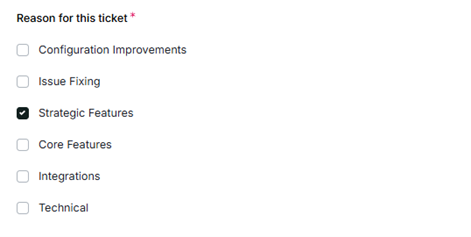
Pop-Up Before Deletion
Configuration Required
To help prevent accidental data loss, we’ve introduced a confirmation pop-up when (soft) deleting repeaters within a form. This extra step gives users the opportunity to review and confirm their action, reducing the risk of unintended deletions and providing greater peace of mind. We’ve also made this feature configurable at the platform level, so we’ll leave it disabled for clients who prefer fewer clicks.

Retaining Personalized Grid Filters
Configuration Required
Off by default but configurable site-wide, this feature allows grid filters to be remembered from your last visit. Just like column order and sizing preferences are already saved for your personal view, applied data column filters can now be retained – making it faster and easier to pick up where you left off, without needing to reapply filters each time.

Excel Export from Treeviews
Configuration Required
You can now easily export hierarchical data from treeviews using the familiar End User Export Wizard interface. The system automatically converts this hierarchical data into a flat structure, including a column that shows the associated hierarchy node, making analysis and sharing straightforward and efficient.

Persisting Filters Applied to Dashboards
Configuration Required
We’ve added the ability to enable filter persistence across a site’s dashboards. This means that once you apply filters to a dashboard, they will be remembered the next time you visit it. Additionally, when navigating between dashboards that share the same filters, those filters will be automatically applied, creating a more seamless and consistent user experience. This enables users to save time by not having to reapply filters repeatedly, helps maintain context when reviewing related data, and improves overall efficiency when working across multiple dashboards within CoreStream GRC.

New Bookmarking Feature
Automatically Added
On larger sites with multiple entities, navigating through complex site structures to find the pages you need can take time. To make this faster and easier, we’ve introduced bookmarking. You can now save any frequently used screen as a bookmark for quick access later, all from a single convenient list. Whether you’re jumping between dashboards, grids, or specific forms, bookmarking helps you work more efficiently and keep your most important pages just a click away.


3.2 Core Features
View Versions in Sub Forms
Automatically Added
Version history is no longer limited to top-level forms. You can now review and select from all versions of sub-forms and associated content directly within the main form. This makes it much easier to look back at historical data, compare changes, and get the full picture in one place without jumping between multiple screens.

Configurable Sort Order for Linked Content Pop-Up Grids
Configuration Required
To make it easier to navigate large sets of linked content in pop-up grids, you can now sort by fields other than just the default ID. Choose from numeric, text, or date fields – sorted ascending or descending – to display records in the order that best fits your workflow, whether that’s newest first, alphabetical, or chronological.

Added Sorting to Column Selector Filter
Automatically Added
Columns in the Column Selector on grids can now be sorted alphabetically in either ascending or descending order, while still retaining the search functionality. This makes it much easier to find and manage the columns you need, especially in larger datasets.
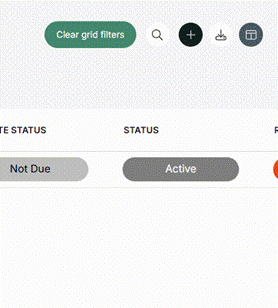
Optional Treeview Search Change
Configuration Required
We’ve introduced an optional enhancement to treeview search that, when enabled, includes all child nodes of a matching node in the results. For example, in a Portfolio-Program-Project hierarchy, searching for a specific program can now also display all associated projects, even if their titles don’t contain the search term. This makes it easier to focus on a higher-level grouping while still seeing the full scope of its related records.

Improved Accessibility and Keyboard Navigation for Notifications
Automatically Added
As part of our ongoing accessibility enhancements, we’ve made it easier for keyboard users to interact with notifications. Now, when a notification appears – whether it’s a group notification at the top-right or a system message at the bottom-right – it will be brought into focus, allowing immediate interaction without the need to tab through the entire page. Once the notification is dismissed, focus is seamlessly returned to the previous element, ensuring a smooth and intuitive experience for all users.
Screen Reader Navigation Enhancements for Improved Accessibility
Automatically Added
As part of our ongoing commitment to accessibility, we’ve enhanced screen reader navigation within forms to provide a smoother and more intuitive experience. Users can now navigate through form fields using arrow keys without unintentionally leaving the form area, ensuring they stay focused and can efficiently interact with all form elements until the form is closed.
Progress Tracker Supported in Excel Exports
Automatically Added
You can now export and analyze progress data into Excel exports alongside the rest of your records. This makes it easier to report on and review progress outside of the platform.

Copy Images Directly into Rich Text Fields
Automatically Added
Previously, adding an image, video, or GIF to a rich text (WYSIWYG) field required saving it locally and then uploading it. Now, you can simply copy and paste an image directly into the field, and CoreStream GRC will handle the upload automatically.

3.3 Configuration Improvements
Improved Efficiency of Configuration for Subsections
Configuration Required
We’ve streamlined the configuration process for subsections, reducing manual effort and repetitive setup for each form. This improvement allows subsections to be applied more broadly and consistently, without introducing the risk of extra manual work later.
Wizard-Based API Export Generator
Automatically Added
Many clients use our API export functionality to securely access data from one or more tables – often for automated business intelligence (BI) reporting. While technical client contacts can and do work with raw data, most prefer the data to be slightly transformed with the required manual joins already in place. This meant our data team spent considerable time rewriting queries into a more digestible format. In 3.1, we’ve introduced a wizard-based API export generator, enabling our configuration team to create optimized queries for clients in just a few clicks – no SQL expertise required. This not only frees up our data team for higher-value work but also allows project teams to deliver results to clients more quickly.

3.4 Issue Fixing
Small Improvement to Field-Level Version History
Automatically Added
In CoreStream GRC, the fields in our collections (data tables) can have three different names: The internal name, which is what the system uses to identify the field (e.g. LocalRiskDescription); the display name, which is what is used by default across the platform (e.g. Local Risk Description); a name used on a specific form – perhaps to add more context or be more concise (e.g. Risk Description). Previously, the field-level version history in forms displayed the collection’s display name, which didn’t always match the name shown in the form – sometimes causing confusion when tracking changes. We’ve now aligned the field-level version history to use the form’s field name, making it easier to identify exactly which field was updated over time.
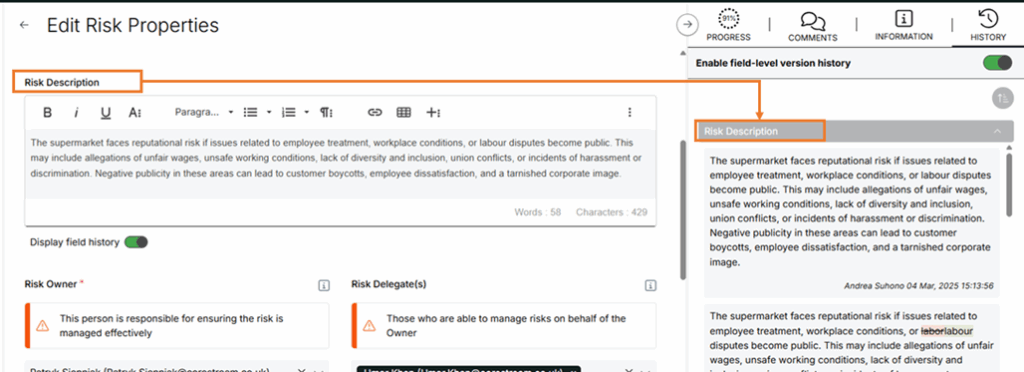
Fixed Links to Specific Forms from Email Reminders
Automatically Added
We resolved an issue where links in email reminders were not directing users straight to the intended form within a grid. Now, clicking these links will take users directly to the specific form, improving navigation and user experience.

Bug Fix for Placeholder Text in WYSIWYG Fields
Automatically Added
Placeholder text can be used to guide users when completing rich text (WYSIWYG) fields – for example, giving them structure or a brief tip on completing the field. They display in light grey when the field is empty as a prompt to the user – but previously, they wouldn’t display unless you clicked into the field. Clicking into the field to “activate” it to see the placeholder text is no longer necessary; placeholder guidance is immediately visible, making forms quicker and easier to complete.

3.5 Integrations
SSH Key Authentication
Configuration Required
We’ve added SSH key authentication to the growing list of supported authentication methods for our generic (configurable) integrations. This allows for secure, password-less connections between CoreStream and external systems, reducing the risk of credential compromise and improving automation reliability.
Key Value Pair Authentication
Configuration Required
We’ve added support for key-pair authentication to our CSV export capability over SFTP. This provides a more secure, password-less method of transferring files, ensuring sensitive data can be exported and delivered to external systems with stronger protection and reduced risk of credential theft.
3.6 Technical
Using SendGrid for Outbound Emails
Automatically Added
We’ve moved to using SendGrid as the default service for sending outbound emails. Previously, all messages were sent through our own SMTP server. SendGrid offers enhanced security through industry-standard encryption, improved authentication, and advanced email validation, reducing the risk of spoofing or tampering. This ensures your communications are delivered more reliably and securely.
About Rich Eddolls
Richard is a co-founder and Chief Product Officer at CoreStream GRC, where he’s redefining the way organizations approach governance, risk, and compliance. With 20 years of experience in business-driven GRC system design and a background at Deloitte, Richard is all about challenging the status quo and delivering technology that actually works. As the visionary behind the CoreStream GRC platform, he’s committed to building solutions that don’t just promise change—but deliver it. Outside of the office, Rich is a golfer, soccer player, and proud husband and father, always looking for the next challenge—whether on the field or at home.
Follow Rich on LinkedIn here.
About Cam McNair
Cam is Head of Platform Design at CoreStream GRC, where he’s redefining how platform innovation happens—from solving day-to-day configuration challenges to building out features that scale. With a background in data analysis and technical solution design, Cam’s all about turning complex business needs into simple, powerful tools that actually work. He leads a team of Solution Architects who double as Product Owners, delivering real impact across the platform. As the driving force behind CoreStream GRC’s product evolution, Cam’s focused on creating solutions that don’t just tick boxes, but move things forward.
See Cam’s LinkedIn post about Product Release 3.0
Follow Cam on LinkedIn here.
